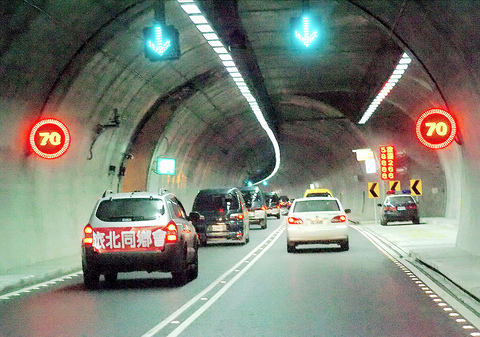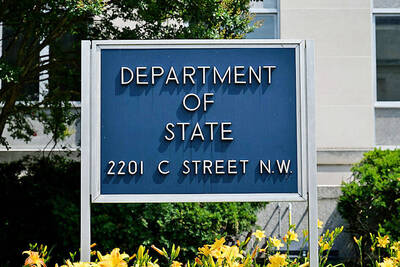The opening of the Hsuehshan Tunnel yesterday drew crowds of motorists eager to be among the first ones through -- creating a traffic jam that saw bumper-to-bumper traffic backed up for 1km outside the tunnel entrance.
The Ministry of Transportation and Communications (MOTC) officially opened the 12.9km tunnel -- Asia's longest and the world's fourth-longest -- at 1pm. Some motorists were so enthusiastic about being the first through the tunnel that they had started lining up well before then. It took less than an hour for a huge traffic jam to form.
Reports from the Taiwan Area National Freeway Bureau yesterday showed that more than 1,000 cars drove through the tunnel each hour.

PHOTO: FANG PIN-CHAO, TAIPEI TIMES
One driver told the Taipei Times that she and other drivers were forced to stop at the entrance for a while before they could get inside. Once inside the tunnel, however, she was able to drive at more than 40kph and sometimes up to the 50kph minimum speed required by the MOTC.
Motorists were not penalized on the first day for driving below the speed limit, the National Highway Police Bureau said. According to the bureau, one driver was caught violating lane-switching rules.
The construction of the tunnel took 15 years and cost a total of NT$90.6 billion (US$2.83 billion). The project has continued through the administrations of seven premiers and 10 MOTC ministers.
An unveiling ceremony was held yesterday for a monument commemorating 25 workers who lost their lives during the tunnel's construction.
The ceremony was jointly attended Premier Su Tseng-chang (蘇貞昌), three other former premiers -- Chang Chun-hsiung (張俊雄), Yu Shyi-kun and Frank Hsieh (謝長廷), MOTC minister Kuo Yao-chi (郭瑤琪), and family members of the deceased workers. Government officials and family members presented white roses to honor the deceased workers' sacrifice. The sandstone monument, which is shaped like a mountain, includes the names of those who died, along with a brief introduction regarding the construction of the highway.
Kuo recounted the challenges of constructing the tunnel in a speech. She said it took the ministry an average of one year to build one kilometer of the tunnel.
Engineers encountered massive inflows of water on 13 occasions. One of the tunnel-boring machines was buried in a collapse.
"It was considered one of the world's most difficult construction projects by Encyclopedia Britannica," Kuo said.
The event then arranged for Su, Hsieh, Yu and Chang to ride together in a jeep through the tunnel. Su, the designated driver, happily presented his driver's license to the press. However, it took Su almost 15 minutes to figure out how to drive a stick-shift car before he was able to hit the road.
Hsuehshan Tunnel statistics
* It is Asia's longest tunnel and the world's fourth longest, at 12.9km. It is the world's largest two-shaft tunnel.
* It's surrounded by the world's largest network of tunnels, 58 in total.
The total depth of the six ventilation shaft is 2,437m, nearly five times the height of Taipei 101 (508m).
* 5,090,000 cubic meters of earth and stone were dug out to construct the tunnel - a volume equivalent to five Chiang Kai-shek Memorial Halls.
* Nearly 370,000 cubic meters of concrete were used in the construction, seven times more than that used to construct Taipei 101.
* The tunnel uses 20,000 illuminating units, equivalent to the lighting of six Tianmu baseball stadiums.
* 2,000km of cables were installed for the traffic control system and core mechanical system of the tunnel - enough to wrap around the nation's coastline twice.
Source: Taiwan Area National Expressway Engineering Bureau

A car bomb killed a senior Russian general in southern Moscow yesterday morning, the latest high-profile army figure to be blown up in a blast that came just hours after Russian and Ukrainian delegates held separate talks in Miami on a plan to end the war. Kyiv has not commented on the incident, but Russian investigators said they were probing whether the blast was “linked” to “Ukrainian special forces.” The attack was similar to other assassinations of generals and pro-war figures that have either been claimed, or are widely believed to have been orchestrated, by Ukraine. Russian Lieutenant General Fanil Sarvarov, 56, head

SAFETY FIRST: Double the number of police were deployed at the Taipei Marathon, while other cities released plans to bolster public event safety Authorities across Taiwan have stepped up security measures ahead of Christmas and New Year events, following a knife and smoke bomb attack in Taipei on Friday that left four people dead and 11 injured. In a bid to prevent potential copycat incidents, police deployments have been expanded for large gatherings, transport hubs, and other crowded public spaces, according to official statements from police and city authorities. Taipei Mayor Chiang Wan-an (蔣萬安) said the city has “comprehensively raised security readiness” in crowded areas, increased police deployments with armed officers, and intensified patrols during weekends and nighttime hours. For large-scale events, security checkpoints and explosives

PUBLIC SAFETY: The premier said that security would be tightened in transport hubs, while President Lai commended the public for their bravery The government is to deploy more police, including rapid response units, in crowded public areas to ensure a swift response to any threats, President William Lai (賴清德) said yesterday after a knife attack killed three people and injured 11 in Taipei the previous day. Lai made the remarks following a briefing by the National Police Agency on the progress of the investigation, saying that the attack underscored the importance of cooperation in public security between the central and local governments. The attack unfolded in the early evening on Friday around Taipei Main Station’s M7 exit and later near the Taipei MRT’s Zhongshan

REBUFFED: In response to Chinese criticism over recent arms sales, Washington urged Beijing to engage in meaningful dialogue instead of threats and intimidation Washington’s long-term commitment to Taiwan would not change, the US Department of State said yesterday, urging Beijing to stop pressuring Taiwan and engage in meaningful bilateral dialogues. The remarks came in response to a backlash from Beijing about Washington’s latest approval of arms sales to Taiwan. The US Defense Security Cooperation Agency said in a statement on Wednesday that the Taipei Economic and Cultural Representative Office in the US has asked to purchase an arms package, including Tactical Mission Network Software; AH-1W helicopter spare and repair parts; M109A7 self-propelled howitzers; HIMARS long range precision strike systems; tube-launched, optically tracked, wire-guided missiles; Javelin